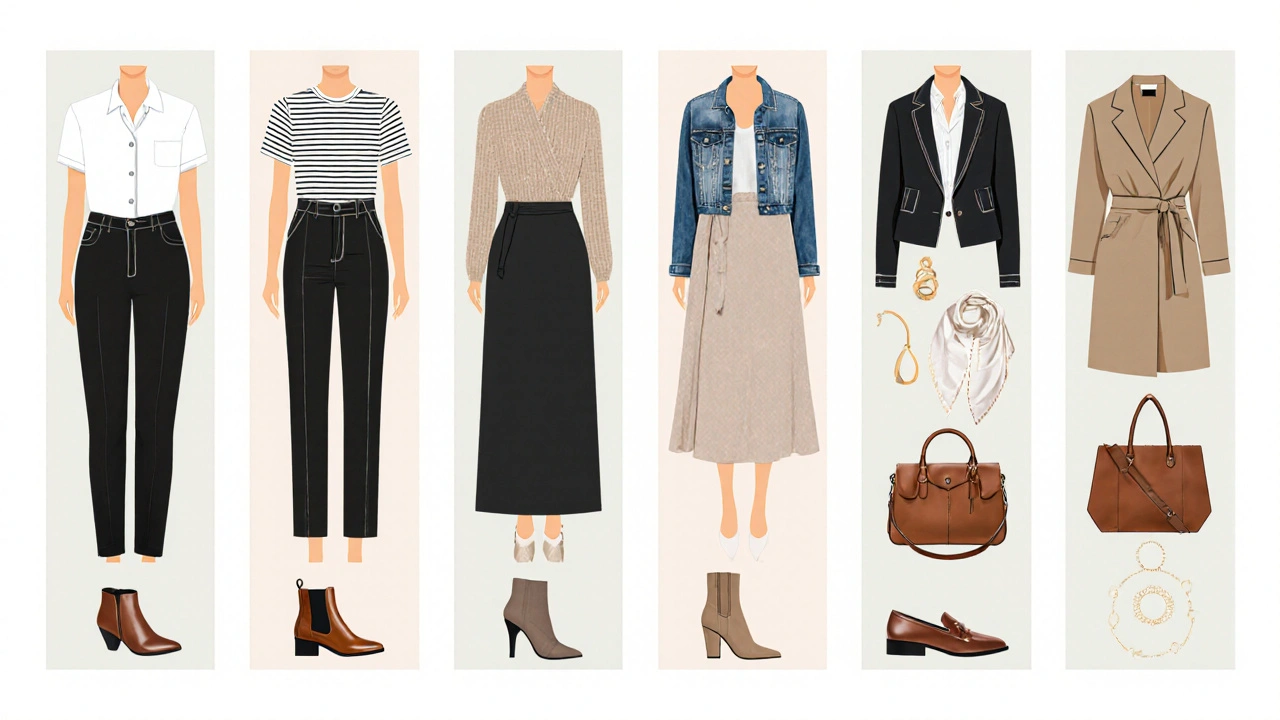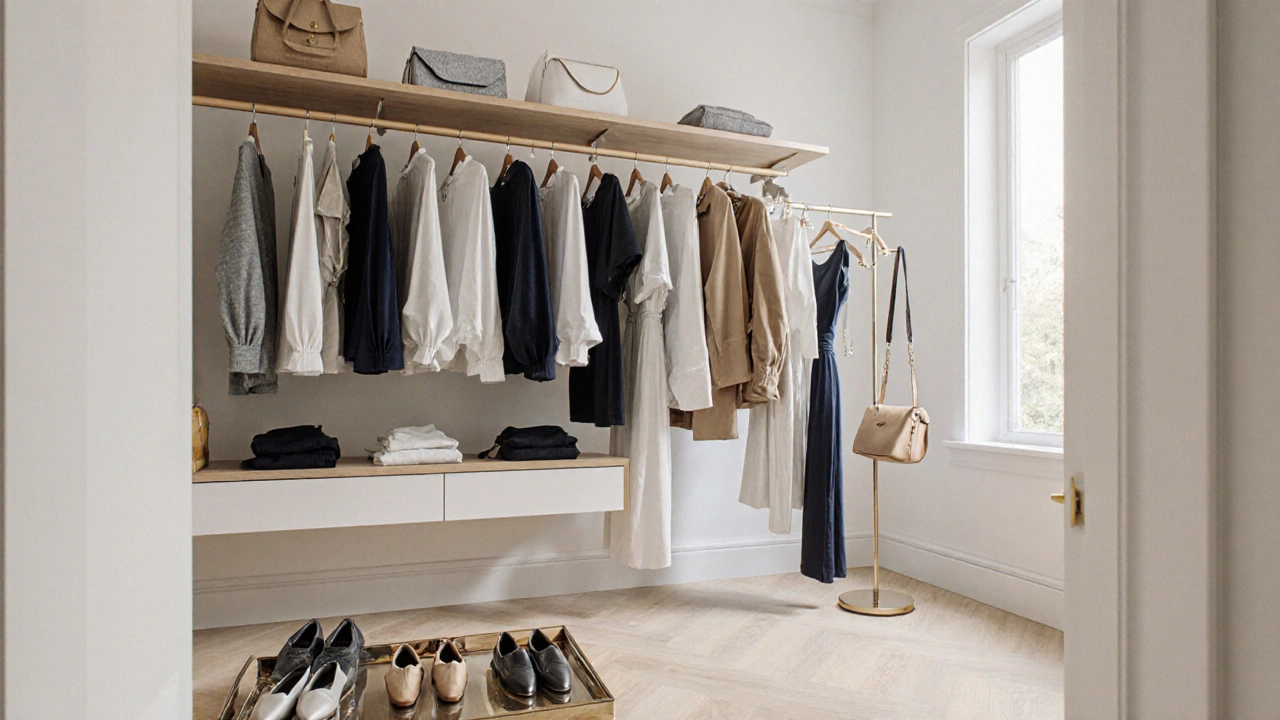33 Piece Wardrobe Calculator
Calculate how many outfit combinations your current wardrobe can create based on the 33 piece capsule wardrobe principle. Simply input how many items you have in each category below.
Your Results
How to use: Enter the number of items you have in each category. The calculator will show you how many outfits you can create and how close you are to the ideal 33-piece wardrobe.
Ever wondered why some fashion blogs rave about a 33 piece wardrobe while others stick to vague "capsule" ideas? It’s basically a curated set of clothes that lets you mix‑and‑match enough outfits to cover work, weekend, and everything in between-without owning a closet that looks like a tornado hit it.
What the 33 Piece Wardrobe Actually Is
At its core, the 33 piece wardrobe is a specific version of a capsule wardrobe. It includes 33 individual items: tops, bottoms, dresses, outerwear, shoes, and accessories, all chosen to work together. The magic number isn’t random; it’s enough pieces to give you roughly 50‑70 outfit combinations while keeping your wardrobe lean.
Why 33? The Numbers Behind the Concept
Most people estimate they need 40‑60 items to feel comfortable year‑round. Researchers at the University of Minnesota found that the average adult woman owns 102 tops alone. By trimming down to 33, you cut waste, simplify decisions, and still look fresh. The formula most enthusiasts use is:
- 12 tops
- 6 bottoms
- 4 dresses (or jumpsuits)
- 3 outerwear pieces
- 2 pairs of shoes
- 6 accessories (scarves, belts, bags, jewelry)
- 0‑1 specialty item for occasions
This breakdown balances variety with repeatability. You can swap a button‑down for a tee, layer a cardigan, or add a statement necklace to instantly shift the vibe.
How It Differs From a Regular Capsule Wardrobe
| Aspect | 33 Piece Wardrobe | Typical Capsule (≈30 items) |
|---|---|---|
| Item Count | 33 exact pieces | ≈30, often vague range |
| Structure | Fixed categories (12 tops, 6 bottoms, …) | Broad categories, less specificity |
| Outfit Potential | 50‑70 combos | 30‑50 combos |
| Seasonal Flexibility | Built‑in layering pieces | Often requires extra seasonal swaps |
| Focus | Minimalist closet with clear rules | General minimalist intent |
The extra three items usually go to accessories or a specialty shoe, which gives the 33‑piece version a tiny edge in personalization.

Core Pieces You’ll Need
Below is a quick checklist. Each item should be in a neutral palette (think black, white, navy, gray, or camel) so everything pairs effortlessly.
- White button‑down shirt
- Classic striped tee
- Silk blouse
- Lightweight knit sweater
- Denim jacket
- Tailored blazer
- Black trousers
- Straight‑leg jeans
- Pencil skirt
- Midi dress
- Wrap dress
- Cozy cardigan
- Trench coat
- Leather ankle boots
- Classic loafers
- Silk scarf
- Leather belt
- Structured tote
- Crossbody bag
- Minimalist jewelry set
That’s only 20 items listed, leaving room for a few seasonal pieces (like a wool coat or summer sandals) and the extra accessories to reach the 33 count.
Building Your Own 33 Piece Wardrobe
Step‑by‑step, here’s how to go from a cluttered closet to a focused 33‑piece system:
- Do a closet audit. Pull everything out and categorize into “keep,” “donate,” and “sell.”
- Identify your lifestyle needs: office days, casual weekends, social events. Write them down; they become the wardrobe basics you must cover.
- Pick a neutral color palette. This is the secret sauce of the sustainable fashion approach-fewer fast‑fashion impulse buys.
- Fill each of the 7 categories (tops, bottoms, etc.) with items that meet your style and fit the palette.
- Test outfit combinations. If you can’t create at least 50 looks, swap a piece that feels redundant.
- Document the final list in a spreadsheet. Mark items you can replace seasonally without breaking the system.
Stay flexible: the 33‑piece rule is a guide, not a prison. If a new coat costs less than two older pieces you’d replace, it’s an upgrade, not a rule‑breaker.
Maintenance Tips to Keep It Fresh
Once you’ve built the system, treat it like a garden-regular pruning prevents overgrowth.
- Seasonal Review: Every 3‑4 months, assess each piece for wear, trends, or lifestyle changes.
- Rotate accessories. A bright scarf can breathe new life into a monochrome outfit.
- Invest in quality over quantity. A well‑made blazer lasts years and reduces the need for replacements.
- Mind laundry. Over‑washing drags fabric integrity; follow care labels.
By keeping the collection tight, you avoid the “what to wear” paralysis that many report with larger closets.

Is the 33 Piece Wardrobe Right for You?
If you love the idea of a clutter‑free closet but worry about being under‑dressed, ask yourself:
- Do you have a fairly consistent daily dress code? (If you switch between office suits and gym gear daily, you might need a few extra performance pieces.)
- Are you okay with re‑wearing the same items? The system thrives on repeat wear.
- Do you enjoy planning outfits? Some people love the puzzle; others prefer a “grab‑and‑go” approach.
Answering yes to at least two questions means the 33‑piece method will likely feel liberating rather than restrictive.
Key Takeaways
- The 33 piece wardrobe is a defined version of a capsule wardrobe, using 33 specific items to maximize outfit combos.
- Its structure (12 tops, 6 bottoms, etc.) provides clear guidance while still allowing personal flair.
- Neutral colors, versatile pieces, and thoughtful accessories keep the system flexible across seasons.
- Regular audits and quality investments make the wardrobe sustainable and low‑maintenance.
- It works best for people with a relatively stable daily dress code and who enjoy curating outfits.
Frequently Asked Questions
How many tops should I have in a 33 piece wardrobe?
Aim for about 12 tops, mixing tees, shirts, blouses, and light sweaters. This range lets you layer or wear each piece on its own.
Can I include seasonal items like a heavy coat?
Yes. Seasonal pieces count toward the 33 limit, but they should replace a core item during that season rather than add on top of the set.
What’s the biggest mistake beginners make?
Buying trendy, never‑mix‑and‑match items that clash with the neutral palette. Those pieces waste space and break the system’s versatility.
How do I calculate outfit combinations?
Multiply the number of tops by bottoms, then add dresses, and factor in layers (jackets, scarves). For a typical 33‑piece set, you’ll land around 60 unique looks.
Is the 33 piece wardrobe suitable for men?
Absolutely. Men can follow the same count, adjusting categories to suit their style-think shirts, chinos, outerwear, shoes, and accessories.


Write a comment